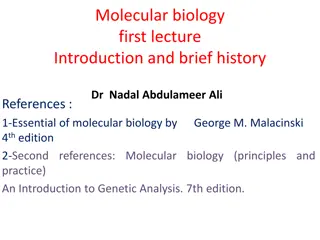Understanding DNA Ligation Techniques for Molecular Biology Applications
DNA ligation involves joining DNA fragments to vectors to create new DNA or plasmids. Methods include DNA ligase, T4 ligase, and terminal deoxynucleotidyl transferase. Linkers and adaptors play a key role in DNA cloning experiments by generating sticky ends for DNA cloning. The use of adaptors allows for combining DNA molecules with different ends, enhancing molecular biology research.
Download Presentation

Please find below an Image/Link to download the presentation.
The content on the website is provided AS IS for your information and personal use only. It may not be sold, licensed, or shared on other websites without obtaining consent from the author. Download presentation by click this link. If you encounter any issues during the download, it is possible that the publisher has removed the file from their server.
E N D
Presentation Transcript
LIGATION OF DNA FRAGMENTS WITH VECTORS
LIGATION OF DNA FRAGMENT WITH VECTORS DNA ligation is the act of joining together DNA strands with covalent bonds with the aim of making new viable DNA or plasmid. There are currently three methods for joining DNA fragments in vitro. The 1st of these is DNA ligase that covalently joins the annealed cohesive ends produced by certain restriction enzymes. The 2nd depends upon the ability of DNA ligase from phage T4-infected E. coli to catalyse the formation of phosphodiester bonds.
The 3rd utilizes the enzyme terminal deoxynucleotidyl transferase to synthesize homopolymeric 3 single-stranded tails at the ends of fragments. E.coli and phage T4 encode an enzyme DNA ligase -T4 enzyme requires ATP while the E. coli enzyme requires NAD+. DNA fragments with either sticky ends or blunt ends can be inserted into vector DNA with the aid of DNA ligases.
LINKERS & ADAPTORS Linker is a synthetic ,short and known double stranded oligonucleotides sequence. Having blunted ends on both sides and restriction sites. E.Coli DNA ligase will not catalyse blunt end ligation except under special condition. Linker can be ligated to both ends of the foreign DNA.
Treatment with R.E produces sticky ends after ligation with target DNA. Sticky ends are desirable for DNA cloning experiments. One drawback is R.E. used to generate cohesive end in the linker will also cut foreign DNA at internal sites. Solution to the problem is to choose another restriction enzyme or to methylate internal restriction sites on the foreign DNA.
Alternatively a chemically synthesized adaptor molecule which have a performed cohesive end can be used. An adaptor is a short, chemically synthesized, double stranded DNA molecule which is used to link the ends of two other DNA molecules. The adaptor molecule have one blunt end bearing 5 phosphate group & a cohesive end which is not phosphorylated.
The use of adaptors: (a) the actual structure of an adaptor, showing the modified 5 -OH terminus; (b) conversion of blunt ends to sticky ends through the attachment of adaptors.
The foreign DNA plus added adaptors is then phosphorylated at the 5 termini and ligated into the vector. Problems: sticky end of adaptors will binds with each other so treatment with Alkaline Phosphates. After attachment with target treatment Polynucleotide Kinase to add P OH at 5 prime. The basic difference between an adaptor & linker is that the former has cohesive ends & the latter has blunt ends.
CLONING FOREIGN DNA BY ADDING ADAPTORS
HOMOPOLYMER TAILING Method for joining DNA molecules make use of the annealing of complementary homopolymer sequence. Addition of oligo(dA) sequences to the 3 ends of one DNA molecule & oligo(dT) blocks to the 3 end of another population. The enzyme terminal deoxynucleotidyl transferase will catalyze the addition of a string of nucleotides to the 3' end of a DNA fragment. One can add a string of G's to the 3' ends of one fragment and a string of C's to the 3' ends of the other fragment.
Homopolymer tailing: (a ) synthesisof a homopolymer tail; (b) construction of a recombinant DNA molecule from a tailed vector plus tailed insert DNA; (c) repair of the recombinant DNA molecule.
A DNA fragment Tarminal transferase add poly-dT nucleotide Restriction enzyme Terminal transferase and poly-d A nucleoticle Insertion























